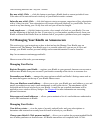
Government Standards for Radio Frequency Signals
In 1991-92, the Institute of Electrical and Electronics Engineers (IEEE) and the American National
Standards Institute (ANSI) joined in updating ANSI’s 1982 standard for safety levels with respect to
human exposure to Radio Frequency (RF) signals. More than 120 scientists, engineers and physicians
from universities, government health agencies, and industries developed this standard.
In 1993, the Federal Communications Commission (FCC) adopted this updated standard. In August
1996, the FCC adopted a hybrid standard consisting of the existing ANSI/IEEE standard and the
guidelines published by the National Council of Radiation Protection and Measurements (NCRP).
The Kindle design complies with updated NCRP standards.
FCC Notice
This device complies with part 15 of the FCC Rules. Operation is subject to the following two
conditions: (1) This device may not cause harmful interference, and (2) this device must accept any
interference received, including interference that may cause undesired operation.
This equipment has been tested and found to comply with the limits for a Class B digital device,
pursuant to part 15 of the FCC Rules. These limits are designed to provide reasonable protection
against harmful interference in a residential installation. This equipment generates, uses, and can
radiate radio frequency energy and, if not installed and used in accordance with the instructions, may
cause harmful interference to radio communications. However, there is no guarantee that interference
will not occur in a particular installation.
If this equipment does cause harmful interference to radio or television reception, which can be
determined by turning the equipment off and on, the user is encouraged to try to correct the
interference by one or more of the following measures: Reorient or relocate the receiving antenna.
Increase the separation between the equipment and receiver. Connect the equipment into an outlet on
a circuit different from that to which the receiver is connected. Consult the dealer or an experienced
radio/TV technician for help. Changes or modifications not expressly approved by the party
responsible for compliance could void the user‘s authority to operate the equipment.
This device meets the FCC Radio Frequency Emission Guidelines and is certified with the FCC as
FCC ID number: UUU-L7E20070323
Radio Frequency Exposure Information (SAR)
This device meets the government’s requirements for exposure to radio waves. This device is
designed and manufactured not to exceed the emission limits for exposure to radio frequency (RF)
energy set by the U.S. Federal Communications Commission.
The exposure standard for wireless devices employs a unit of measurement known as the Specific
Absorption Rate, or SAR. The SAR limit set by the FCC is 1.6 W/kg. Tests for SAR are conducted
using standard operating positions accepted by the FCC with the device transmitting at its highest
certified power level in all tested frequency bands. Although the SAR is determined at the highest
certified power level, the actual SAR level of the device while operating can be well below the
maximum value. This is because the device is designed to operate at multiple power levels so as to
use only the power required to reach the network. In general, the closer you are to a wireless
base-station antenna, the lower the power output. The highest measured SAR value for the device as


















